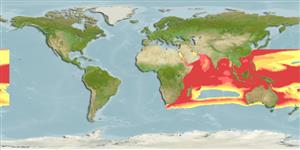>
Eupercaria/misc (Various families in series Eupercaria) >
Monodactylidae (Moonyfishes or fingerfishes)
Etymology: Monodactylus: Greek, monos = one + Greek, daktylos = finger (Ref. 45335).
More on author: Linnaeus.
Environment: milieu / climate zone / depth range / distribution range
Écologie
marin; eau douce; saumâtre; profondeur 0 - 12 m (Ref. 86942). Tropical; 24°C - 28°C (Ref. 1672); 31°N - 42°S, 19°E - 169°W
Indo-West Pacific: Red Sea and east coast of Africa south to the Breë River (Ref. 7293, 52193); also the Persian Gulf (Ref. 96822) to Samoa, north to the Yaeyamas, south to New Caledonia and Australia (Ref. 4959). Known from the freshwater tidal zone of the Mekong delta (Ref. 12693).
Length at first maturity / Taille / Poids / Âge
Maturity: Lm 13.0 range ? - ? cm
Max length : 27.0 cm SL mâle / non sexé; (Ref. 44894); common length : 12.0 cm TL mâle / non sexé; (Ref. 5450)
Épines dorsales (Total) : 7 - 8; Rayons mous dorsaux (Total) : 27 - 31; Épines anales: 3; Rayons mous anaux: 27 - 32.
Found in bays, mangrove estuaries, tidal creeks, and lower reaches of freshwater streams (Ref. 2847, 44894, 48636); occasionally in silty coastal reefs (Ref. 9710). It feeds on plankton and detritus (Ref. 5213, 44894). Commonly seen in large schools (Ref. 44894, 52193); small juveniles either solitary or in small aggregations (Ref. 48635). Usually only juveniles enter freshwater (Ref. 52193). Highly territorial (Ref. 9710). Caught with throw nets (Ref. 30573).
Life cycle and mating behavior
Maturité | Reproduction | Frai | Œufs | Fécondité | Larves
Heemstra, P.C., 1984. Monodactylidae. In W. Fischer and G. Bianchi (eds.) FAO species identification sheets for fishery purposes. Western Indian Ocean (Fishing Area 51). Vol. 3. FAO, Rome. [pag. var.]. (Ref. 7293)
Statut dans la liste rouge de l'IUCN (Ref. 130435: Version 2024-1)
Menace pour l'homme
Harmless
Utilisations par l'homme
Pêcheries: intérêt commercial mineur; Aquarium: Commercial
Outils
Articles particuliers
Télécharger en XML
Sources Internet
Estimates based on models
Preferred temperature (Ref.
123201): 22.9 - 28.8, mean 27.6 °C (based on 638 cells).
Phylogenetic diversity index (Ref.
82804): PD
50 = 0.5781 [Uniqueness, from 0.5 = low to 2.0 = high].
Bayesian length-weight: a=0.02818 (0.01685 - 0.04715), b=3.00 (2.85 - 3.15), in cm total length, based on LWR estimates for this species & (Sub)family-body (Ref.
93245).
Niveau trophique (Ref.
69278): 3.1 ±0.26 se; based on food items.
Fishing Vulnerability (Ref.
59153): Low vulnerability (23 of 100).
Nutrients (Ref.
124155): Calcium = 187 [94, 330] mg/100g; Iron = 1.44 [0.85, 2.58] mg/100g; Protein = 18.3 [17.2, 19.3] %; Omega3 = 0.172 [0.089, 0.312] g/100g; Selenium = 32.5 [15.1, 68.3] μg/100g; VitaminA = 14.6 [4.7, 46.6] μg/100g; Zinc = 1.89 [1.28, 2.77] mg/100g (wet weight);
